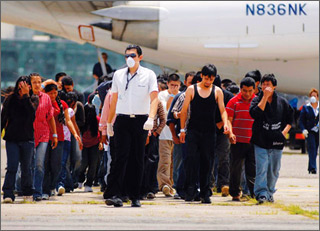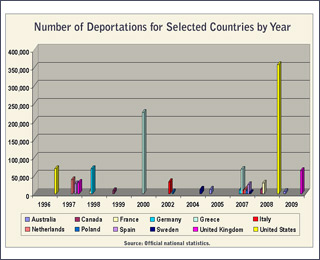Unwanted Immigrants: America’s Deportation Dilemma
Unwanted Immigrants: America’s Deportation Dilemma

NEW YORK: As being played out by the legal battle between the US Government and the state of Arizona, the bottom line in the illegal immigration debate is whether or not to deport those unlawfully resident within a country.
Faced with the growing presence of illegal migrants – many arriving without documents on foot, in backs of trucks, on creaky boats; others overstaying their visas; and still others having asylum claims denied – nations from Angola to Australia, Israel to Italy and the United Kingdom to the United States struggle with this knotty issue.
The deportation dilemma has become more acute due to global recession and widespread joblessness at levels not seen since the Great Depression. Partly as a result, a common perception emerges throughout Europe, North America and elsewhere – “millions of native workers without jobs and millions of jobs without native workers.”
Whereas the global number of illegal migrants is large, estimated at roughly 50 million, those actually deported are considerably less (see Table 1). In the US, for instance, less than 4 percent – or 358,886 – of the estimated 11 million illegal migrants were deported in 2008. While deportations have declined in some countries, such as Germany, Greece and Italy, numbers of deported have increased substantially in others, such as Canada, France, the UK and the US.

Concerning the undesirability of illegal immigration, near universal agreement exists among governments and much of the public, especially when it involves smuggling and trafficking. In fact, governments – especially at intergovernmental gatherings such as the United Nations – uniformly stress national sovereignty, emphasizing rights to monitor borders, manage immigration and pass laws aimed at deterring illegal immigration.
However, and this is the crux of the issue, views and policies differ enormously between sending and receiving countries, such as Mexico and the US, and within countries, such as Israel, Italy, Spain, the UK and the US, on how to deal with millions of men, women and children living unlawfully in scores of countries around the world.
At one extreme are those who contend that deportation is the appropriate and required solution: As illegal migrants are lawbreakers, they should not be rewarded with amnesty or legalization. Relevant laws pertaining to illegal immigration should not be ignored, camouflaged or halfheartedly carried out by responsible authorities. Illegal migrants must go to the back of the line and apply for immigration back in home countries just as legal immigrants have done and continue to do. Granting amnesty to illegal migrants not only undermines the rule of law, erodes public trust and constitutes a slap in the face to all those who migrated legally, this view maintains, but it also encourages future illegal immigration.
At the other extreme are those who oppose deportation, pressing for legalization of unauthorized migrants: Most of these migrants, struggling to meet their most basic needs, simply seek gainful employment to support themselves and improve the lives of their families. Identifying and sending unauthorized migrants back to home countries is costly and logistically difficult. Moreover, widespread deportations can lead to economic disruptions, breakup of families and violations of fundamental civil liberties. Unauthorized migrants should be allowed to reside and work legally in the country, proponents maintain, and permitted to apply for citizenship.
In the middle are the many who tend to equivocate on deportation, depending on circumstances: Unauthorized migrants – and it doesn’t matter from where – who commit serious crimes should be returned to their home countries after serving jail sentences. In contrast, law-abiding unauthorized migrants should be allowed to remain and permitted to apply for citizenship. In particular, unauthorized migrants who arrive as children – and those subsequently born in the country to unauthorized migrants – should be allowed to stay in the country and become citizens.
The political will needed to implement wide-scale deportation programs is normally lacking or weak at best. Politics, voting patterns, economic interests and labor needs, especially evident in Europe, Japan and the US, push political leaders to turn a blind eye to illegal immigration, by and large evading the prickly issue of deportation.
In addition, the costs of identifying, detaining, processing and deporting are considerable. For example, the United Kingdom Border Agency spent the equivalent of about $40 million in 2009 on chartered and scheduled flights to remove illegal migrants. In the US, simply detaining an illegal migrant has average cost of about $100 per day.
Legal deportation proceedings, if they take place at all, frequently give rise to ethical and humanitarian concerns. Sending illegal migrants back to countries with civil conflict or searing poverty, for example, could violate their basic human rights. In some cases, if returned home – especially to war-torn countries – their lives could be endangered by militants and insurgents. Moreover, expulsion of seriously ill or disabled unauthorized migrants, including those with HIV/AIDS, heart disease or cancer as well as mental illness or physical disabilities, to their countries of origin, particularly if least developed, could be a death sentence.
Even when deportation is decided by the courts and ordered by governmental authorities, illegal migrants, especially among the EU countries, increasingly protest court decisions with defiant refusals, including hunger strikes, street demonstrations and appeals to human rights organizations, often leading to lengthy stalemates. Taking up refuge in places such as churches and makeshift camps, some illegal migrants alongside sympathetic supporters challenge physical removal, often with attendant reporters and television crews. In response to heightened visibility and negative public reaction to these removals, some governments, such as France and the UK, deport illegal migrants surreptitiously late at night.
Objections to deportation also arise in the countries of origin, such as Mexico which has spoken out against US deportations and the recent Arizona law. Some nations, such as China, Ethiopia, Eritrea, India, Iran, Jamaica, Laos and Vietnam, refuse to repatriate many of the illegal migrants. Also, origin countries, such as Cambodia, El Salvador, Guatemala and Jamaica, are understandably not keen to receive deported citizens convicted of crimes abroad or linked to organized crime. And the numbers of deported criminals are not inconsequential; the US alone deported close to 100,000 criminals in 2008.
In addition to the loss of valued remittances, returning unauthorized migrants are likely to contribute to unemployment rolls, additional costs and political unrest. Besides new and uncertain economic circumstances, deported migrants often face re-entry difficulties, including stigmatization and depression.
As a result of their inability or unwillingness to return illegal migrants to their home countries, some governments, especially among EU nations such as Italy and Spain, have offered regularization programs to hundreds of thousands. To reduce opposition to amnesty, legalizations programs are frequently labeled as “the last.”
Legalization is often coupled with commitments for increased border, interior and workplace enforcement as well as public information campaigns aimed at discouraging future illegal migration. However, governments acknowledge that offering “last chance” legalization programs likely encourage others to try unlawful entry in hopes of being eligible for the next amnesty, as was the case following the “last” US amnesty to nearly 3 million illegal migrants passed under President Ronald Reagan in 1986.
Political leaders, especially in developed countries, are unlikely to consider amnesty or legalization, not until the economy rebounds and record-setting unemployment rates subside. At the same time, legalization advocates insist that governmental authorities address the plight of the undocumented migrants.
For the foreseeable future, governments and intergovernmental organizations must struggle with the deportation dilemma. And until it’s resolved, illegal migrants must confront the immigration Sword of Damocles.